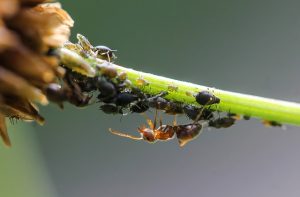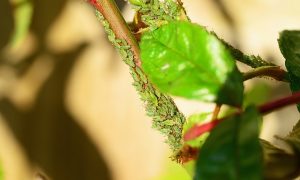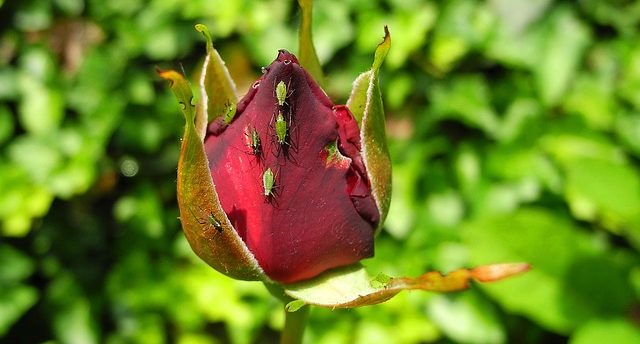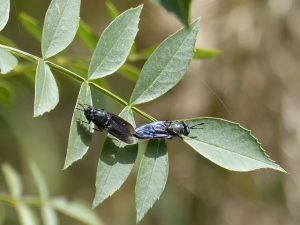Aphids. A very dirty word in the gardening world.
These tiny insects can cause damage to your plants and crops that far outweighs their minute size. By feeding on the sap of young shoots, aphids stunt the growth of the pants, and through the sap which they themselves excrete, they invite whole other types of problems like disease.
One of these problems is called sooty fungus, and this again affects your plants’ ability to grow by infecting the leaves and stopping them from absorbing sunlight.
Aphids like Blackfly and Greenfly are a particular annoyance if you are trying to grow fruits such as tomatoes, strawberries, or blackcurrants, but will also affect tulips, and other types of plants and flowers.
In this article, we will take a look at how to spot signs of damage caused by aphids as well as how to get rid of Blackfly and greenfly.
Spotting aphids or the damage caused by them

One sign that might surprise you, is the evidence of ants. Ants are drawn to the excreted sap, known as honeydew, because of its sweetness and can even be seen ‘farming’ Blackfly. They do this by protecting the Blackfly from other natural predators so that they can feed on that sweet sap for longer. The ants will even bite off the aphid’s wings in order to prevent them flying away, and so it compounds the problem for you.
Other signs that you have a Blackfly or greenfly problem is if the leaves are starting to curl in. If you see this, check on the underside of the leaves to see if there are any aphids there, and also check any young shoots in the same way.
Articles of interest:
As already mentioned above, sooty fungus is another sign that you’ve got an aphid problem. Look for that black layer covering the leaves, and then use one of these methods:
How to get rid of Blackfly and greenfly
Natural ways
There are a few ways to get rid of Blackfly and greenfly, and also some preventative measures you can follow to lessen the risk of a colony developing and causing damage. The first thing you should be doing if growing plants that are known to be susceptible to these aphids, is to check them regularly. If you notice a few aphids, crush them between your fingers before they have time to multiply.
And multiply they will. You see, the females can produce offspring without the need for males, so leaving a few of these insects alone could well turn into a bad mistake as they grow in number exponentially.
Using a jet washer to blast the creatures off the underside of leaves and off shoots can also work, just be careful to use the power washer on a lower setting so it doesn’t damage the plants. A cordless pressure washer is ideal for the lower power settings. You will have to repeat this process every few days though, or you’ll soon find your plants infested again.
Articles of interest:
Using Natural predators
Another natural solution is to stop the ants from protecting the Blackfly and greenfly from their natural predators. How you can do this, is to actually feed the ants yourself with a sucrose solution (30%) and this will satisfy them enough so that they don’t go looking for the honeydew sap created by the aphids. How effective this technique is, is still under debate, but it’s certainly worth a try before you go spraying chemicals around.
If you want to get rid of Blackfly and greenfly in a greenhouse, you could always introduce those predators into the area. Planting things like oregano, dill, and mint will attract Hoverflies and ladybirds who will eat the aphids for you.
Having bird feeding stations set up to attract wrens and other small birds into your garden is another great way to get nature to do the dirty work for you. These birds will feast on the aphids and make light work of them.
Organic sprays
There are organic sprays available to tackle the aphid problem such as ones made from plant oils, fatty acids, or natural pyrethrum.
However, there are pros and cons to these organic sprays. On the plus side, they won’t harm your plants or poison the fruit growing on them, but on the other hand you will have to keep applying these solutions quite regularly to keep the aphids at bay. This is both time consuming, and will raise costs.
Articles of interest:
Chemical solutions
One of the simplest chemical solutions is to mix a small amount of fairy liquid in with some water and then use a sprayer to cover the Blackfly and greenfly, killing them. If using this method, it is best to spray more than once, a few days apart.
Other, stronger insecticides that contain Deltamethrin and other synthetic pyrethroids will have a longer effect than organic ones, but you must take care not to use these on the plant while it is in flower or you could accidentally cause harm to pollinators such as bees.
We have to say that we don’t endorse the idea of using pesticides too much as they can adversely affect the food chain., but we realise some people will be looking for a quick solution and so might be interested in these products.
So, there you have it: Multiple ways to get rid of Blackfly and greenfly.

Obviously, we would suggest always going for the most plant and environmentally friendly option if you can, so try a few out before resorting to chemicals.
You also might be pleasantly surprised that a couple of drops of liquid soap in water can actually work really well, and save you a few quid in the process. Adding a little cayenne pepper to the mix will boost the solution a little more too without harming the plants.
That’s all for today folks but please take a few minutes to explore this site further and you will find articles, reviews and more ready and waiting for you to discover them.

